Estimates of Water Consumption of Growing Pigs under Practical Conditions Based on Climate and Performance Data
Abstract
Simple Summary
Abstract
1. Introduction
2. Animals, Materials and Methods
2.1. Experimental Setup and Data Collection
2.2. Data Analyses
Calculation of Water Consumption in L/Pig and Day, in Relation to Feed Consumption in L/kg FC and in Relation to Body Weight in mL/kg BW
2.3. Statistical Analyses
- measured water consumption: average value for the entire week calculated from the daily consumption;
- BW: average weight of the animal group on the weighing day;
- THI NWSCR: mean value for the whole week calculated from the minute values;
- temperature: average value for the whole week calculated from the minute values;
- feed consumption: average feed consumption per pig and day calculated from the weekly feed consumption calculation.
3. Results
3.1. Water Consumption
3.2. Newly Derived Water Consumption Equations
4. Discussion
- 3.43 L/kg dry matter for ad libitum feeding [27];
- 2 to 4 L/kg dry matter intake, on average 3 L/kg dry matter intake [28];
- 2.43 L/kg (growing phase) and 2.13 L/kg (finishing phase) for dry ad libitum feeding [29];
- 2.90 L/kg, respectively 3.10 L/kg [30];
- 2.05 to 5.43 L/kg feed, on average 3.17 L/kg [12];
- 2.91 to 3.64 L/kg feed [13];
- 2.1 to 5.0 L/kg feed for ad libitum feeding [31];
- 2.05 to 5.22 L/kg feed [32];
- 2.10 to 5.43 L/kg feed for ad libitum feeding [4];
- 2.33 to 5.35 L/kg [33].
5. Conclusions
Author Contributions
Funding
Institutional Review Board Statement
Informed Consent Statement
Data Availability Statement
Acknowledgments
Conflicts of Interest
Appendix A
| Day | 1 | 7 | 25 | 46 | 100 | 150 |
|---|---|---|---|---|---|---|
| exhaust air | ||||||
| temperature curve | ||||||
| initial temperature [°C] | 25.0 | 21.0 | 19.0 | 17.0 | 15.0 | 15.0 |
| heating [°C] | 24.0 | 20.0 | 18.0 | 16.0 | 14.0 | 14.0 |
| ventilation curve | ||||||
| regulating range [K *] | 1.0 | 1.0 | 1.0 | 1.0 | 1.0 | 1.0 |
| minimum [%] | 5 | 5 | 5 | 5 | 5 | 5 |
| maximum [%] | 80 | 80 | 80 | 80 | 80 | 80 |
| supply air | ||||||
| temperature curve | ||||||
| initial temperature [°C] | 24.0 | 19.0 | 17.0 | 15.0 | 13.0 | 13.0 |
| heating [°C] | 23.0 | 18.0 | 16.0 | 14.0 | 12.0 | 12.0 |
| ventilation curve | ||||||
| regulating range [K *] | 1.0 | 1.0 | 1.0 | 1.0 | 1.0 | 1.0 |
| minimum [%] | 10 | 10 | 10 | 10 | 10 | 10 |
| maximum [%] | 70 | 70 | 70 | 70 | 70 | 70 |
| circulating air | ||||||
| temperature curve | ||||||
| initial temperature [°C] | 25.0 | 21.0 | 19.0 | 17.0 | 15.0 | 15.0 |
| heating [°C] | 24.0 | 20.0 | 18.0 | 16.0 | 14.0 | 14.0 |
| ventilation curve | ||||||
| regulating range [K *] | 1.0 | 1.0 | 1.0 | 1.0 | 1.0 | 1.0 |
| minimum [%] | 0 | 0 | 0 | 0 | 0 | 0 |
| maximum [%] | 100 | 100 | 100 | 100 | 100 | 100 |
| References | Morrison and Mount [4] | Mount et al. [31] | Close et al. [32] | Holmes and Mount [33] | Hagsten and Perry [38] | Verstegen et al. [39] |
|---|---|---|---|---|---|---|
| genetic | Large White | Large White | Large White | Large White | no details | Large White |
| sex | castrated male pigs | selection of litter of origin, sex, weight and growth rate according to Holmes and Mount [33] | as with Holmes and Mount [33] | castrated male pigs balanced for sex and the origin of the pigs in relation to the litter, growth rate and weight | crossbred barrows | castrated male pigs selection of litter of origin, weight and growth rate according to Holmes and Mount [33] |
| body weight | mean body weight close to 20 kg | 21–73 kg per pig | initial mean values between 21.0 and 34.0 kg/pig | initial mean values between 20.3 and 61.5 kg/pig | initial mean values between 12 and 49 kg/pig | initial weight: 24–28 kg/pig end weight: 35–45 kg/pig |
| feeding | ad libitum, dry feeding | 42 g feed/kg body weight per day to maximal intake | feeding twice a day “commercial growers” meal from about 9 weeks of age until slaughter 34 g/kg meal per body weight until up to 52 g/kg meal per body weight in stages | four feeding times “commercial growers” meal from about 9 weeks of age until slaughter 42 g feed/kg body weight per day up to a maximum daily meal of 1.83 kg | ad libitum corn-soy-bean meal with supplement salt | feeding twice a day, dry feeding 45 g feed/kg BW and 52 g feed/kg BW at 8 °C 39 g feed/kg BW and 45 g feed/kg BW at 20 °C commercial grower diet |
| water | ad libitum | ad libitum | ad libitum 1 L/kg feed added to the feed | outside the feeding time ad libitum 3 L water mixed with the feed per feeding time | in the pens: deionized water ad libitum in the metabolism stall, twice daily | ad libitum |
| housing | temperature-controlled pen calorimeter * | temperature-controlled pen calorimeter * | temperature-controlled pen calorimeter * | temperature-controlled pen calorimeter * | first pen with 1.22 m × 2.44 m and second pen with 2.44 m × 4.88 m both with concrete floor metabolism stall with 0.35 m × 1.27 m | Calorimeter * |
| climate | temperature controlled, humidity not different temperature levels between 20 and 33 °C | different temperature levels between 7 and 33 °C | different temperature levels between 7 and 30 °C | different temperature levels between 9 and 30 °C | no details | two temperature levels: 8 and 20 °C |
| Reference | Gill [13] |
|---|---|
| genetic | no details |
| sex | male and female pigs, per 12 pigs |
| body weight | start: mean body weight 14.3 kg/pig end: mean body weight 78.2 kg/pig |
| feeding | single feed hopper in every pen with ad libitum feeding, different levels of potassium (K) between 8–17 g K/kg air-dry feed |
| water | ad libitum |
| housing | two performance testing houses with 4 pens |
| climate | temperature between 14.7 and 19.1 °C |


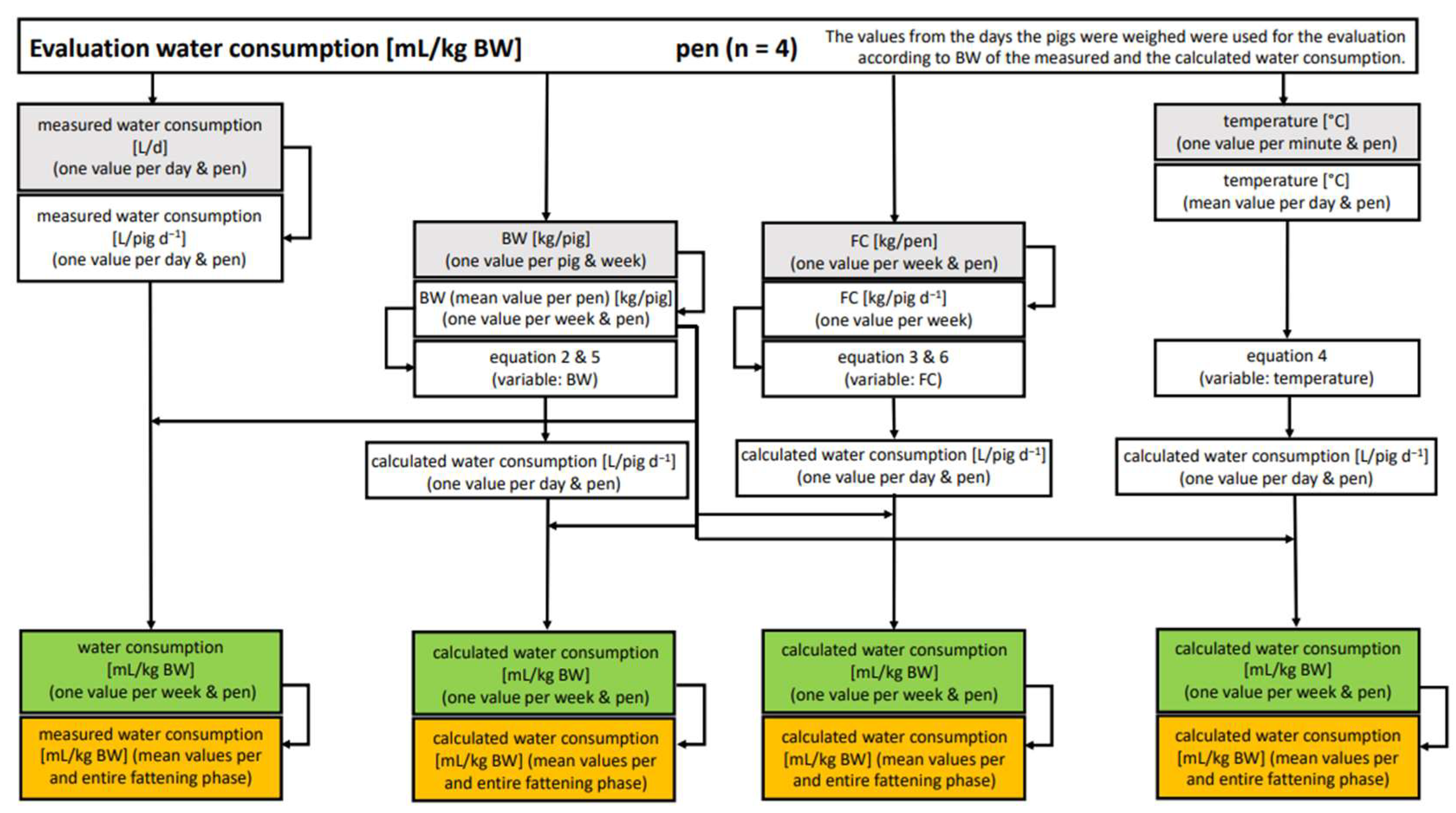
| Experimental Week | Experimental Week | ||||||||||||||
|---|---|---|---|---|---|---|---|---|---|---|---|---|---|---|---|
| 1 | 2 | 3 | 4 | 5 | 6 | 7 | Unit | 1 | 2 | 3 | 4 | 5 | 6 | 7 | |
| parameter | prevalence [%] | CS | 0.11 ± 0.16 | 0.15 ± 0.19 | 0.23 ± 0.21 | 0.12 ± 0.14 | 0.26 ± 0.21 | 0.29 ± 0.19 | 0.38 ± 0.25 | ||||||
| tail lesions | 0.00 | 2.56 | 1.90 | 0.00 | 3.23 | 5.19 | 7.38 | % of CS | 0.00 ± 0.00 | 0.64 ± 3.96 | 0.47 ± 3.42 | 0.00 ± 0.00 | 0.81 ± 4.43 | 1.30 ± 5.57 | 1.85 ± 6.56 |
| ear lesions | 18.57 | 16.03 | 20.89 | 1.27 | 15.48 | 27.92 | 44.97 | 4.64 ± 9.74 | 4.01 ± 9.20 | 5.22 ± 10.19 | 0.32 ± 2.80 | 3.87 ± 9.07 | 6.98 ± 11.25 | 11.24 ± 12.48 | |
| skin lesions (except tail and ears) | 24.05 | 12.82 | 13.92 | 5.06 | 15.48 | 4.55 | 23.49 | 6.01 ± 10.71 | 3.21 ± 8.38 | 3.48 ± 8.68 | 1.27 ± 5.50 | 3.87 ± 9.07 | 1.14 ± 5.22 | 5.87 ± 10.63 | |
| manure on the body | 1.27 | 28.85 | 53.80 | 42.41 | 71.61 | 76.62 | 77.85 | 0.32 ± 2.80 | 7.21 ± 11.36 | 13.45 ± 12.50 | 10.60 ± 12.39 | 17.90 ± 11.31 | 19.16 ± 10.62 | 19.46 ± 10.42 | |
| n [assessment results] 1 | 237 | 156 | 158 | 158 | 155 | 154 | 149 | 237 | 156 | 158 | 158 | 155 | 154 | 149 | |
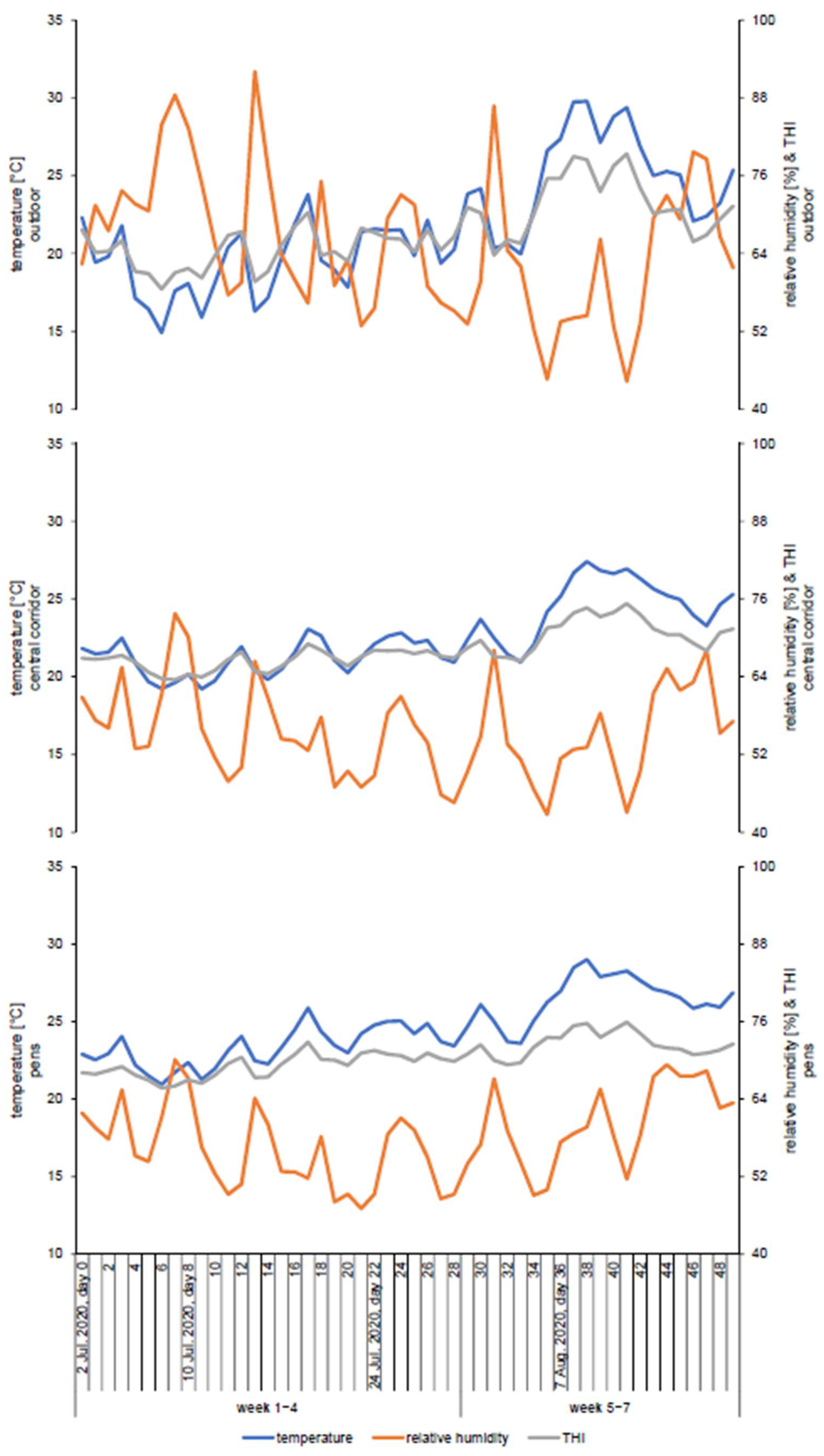
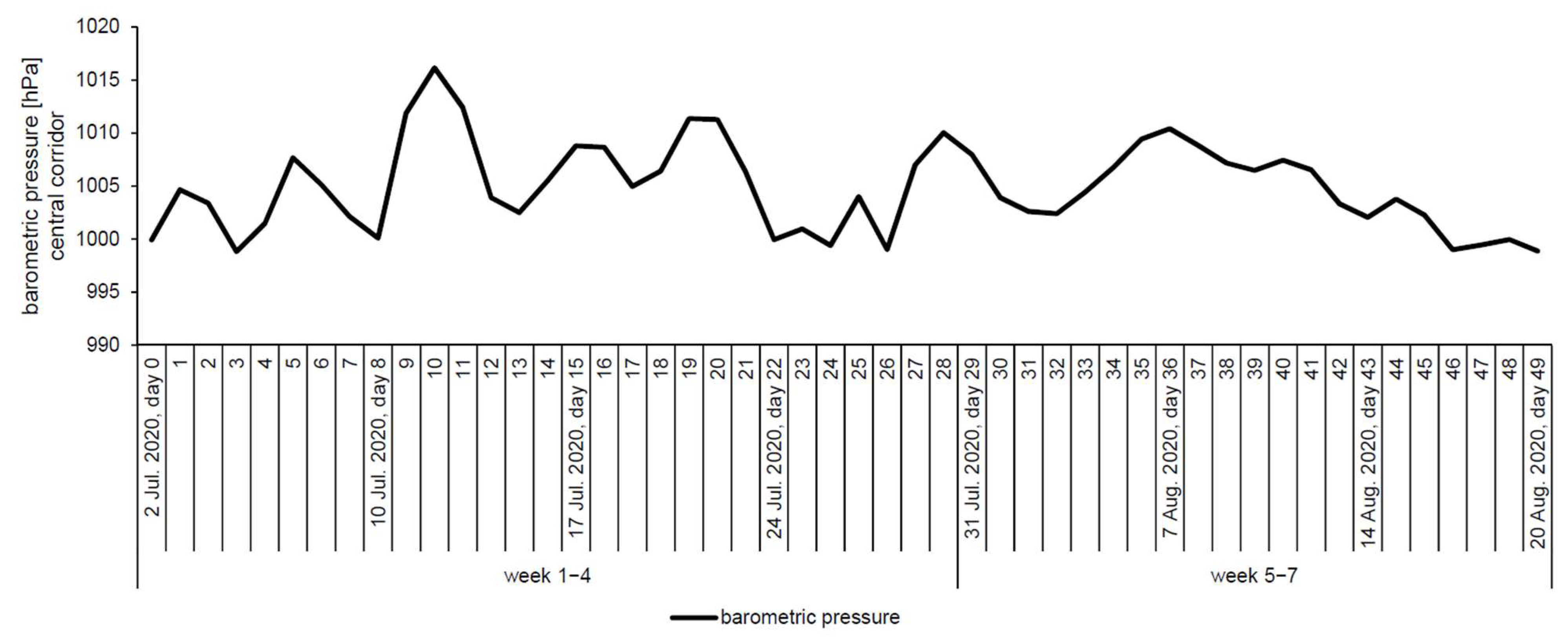

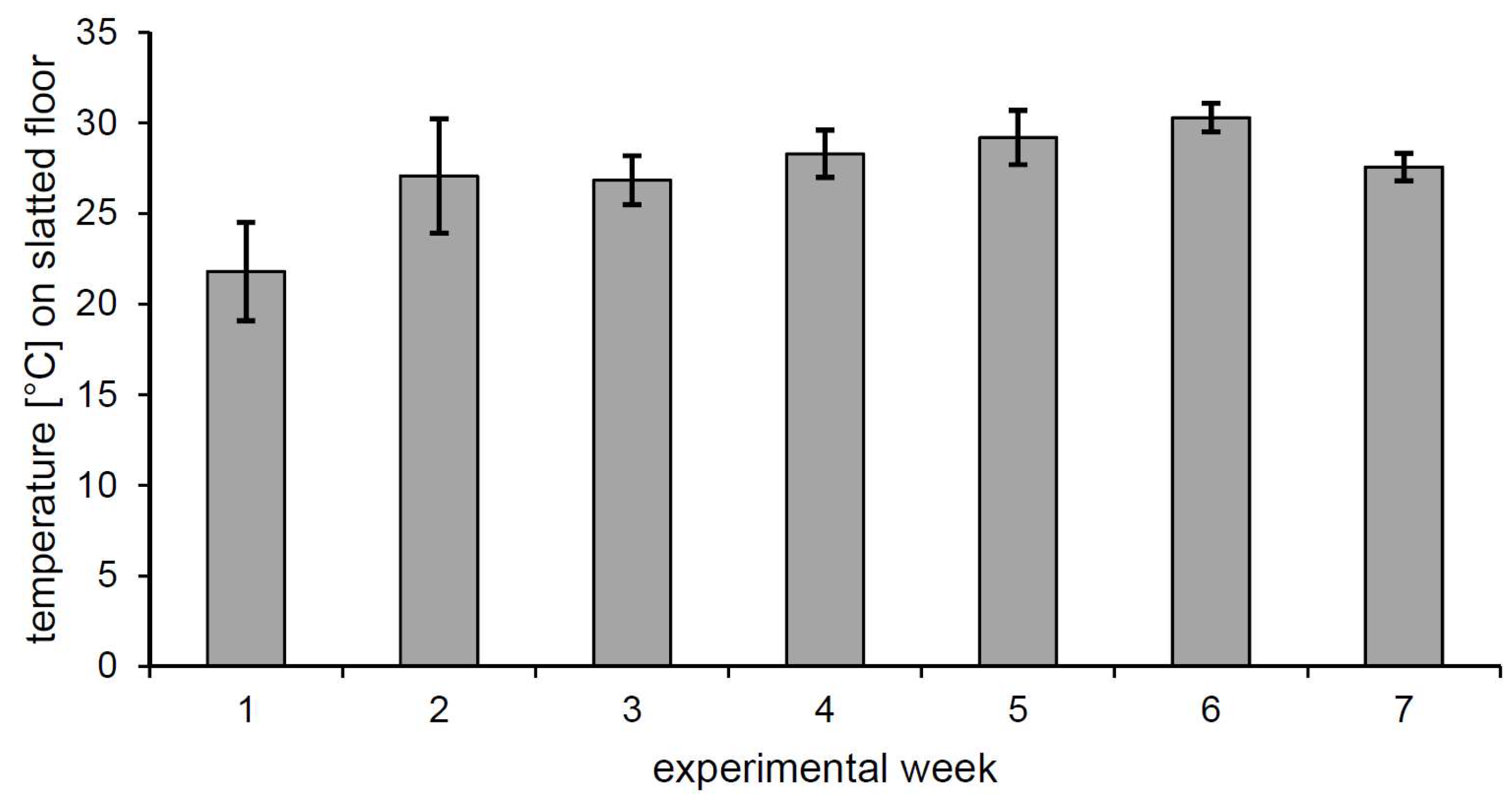
References
- Kamphues, J.; Flachowsky, G.; Rieger, H.; Meyer, U. Für und Wider eine Verabreichung von Futtermittelzusatzstoffen über das Tränkwasser. Übers. zur Tierernährung 2019, 43, 205–248. [Google Scholar]
- Kamphues, J. Zum Wasserbedarf von Nutz- und Liebhabertieren. Dtsch. Tierärztliche Wochenschr. 2000, 107, 297–302. [Google Scholar]
- Straub, G.; Weniger, J.H.; Tawfik, E.S.; Steinhauf, D. The effect of high environmental temperatures on fattening performance and growth of boars. Livest. Prod. Sci. 1976, 3, 65–74. [Google Scholar] [CrossRef]
- Morrison, S.R.; Mount, L.E. Adaptation of growing pigs to changes in environmental temperature. Anim. Sci. 1971, 13, 51–57. [Google Scholar] [CrossRef]
- Ingram, D.L. Evaporative Cooling in the Pig. Nature 1965, 207, 415–416. [Google Scholar] [CrossRef]
- Jessen, C. Wärmebilanz und Thermoregulation. In Physiologie der Haustiere; Engelhardt, W.V., Breves, G., Eds.; Enke in Hippokrates Verlag GmbH: Stuttgart, Germany, 2000. [Google Scholar]
- Brooks, P.H.; Carpenter, J.L. The Water Requirement of Growing-Finishing Pigs—Theoretical and Practical Considerations. In Recent Developments in Pig Nutrition 2; Cole, D.J.A., Haresign, W., Garnsworthy, P.C., Eds.; Nottingham University Press: Nottingham, UK, 1993; ISBN 1-897676-41-7. [Google Scholar]
- Ferch, U. Einfluß hoher Lufttemperatur und hoher Lufttemperatur zusammen mit hoher Luftfeuchtigkeit auf die Körpertemperatur, Atem- und Herzfrequenz beim Schwein. Ph.D. Thesis, Tierärztliche Hochschule Hannover, Hannover, Germany, 1964. [Google Scholar]
- Dikmen, S.; Hansen, P.J. Is the temperature-humidity index the best indicator of heat stress in lactating dairy cows in a subtropical environment? J. Dairy Sci. 2009, 92, 109–116. [Google Scholar] [CrossRef] [PubMed]
- Wegner, K. Untersuchung zu Klimatischen Bedingungen in Sauenställen in Norddeutschland und Deren Einfluss auf Ausgewählte Fruchtbarkeitsparameter von Sauen. Ph.D. Thesis, Justus-Liebig-Universität Gießen, Gießen, Germany, 2014. [Google Scholar]
- TierSchNutztV. Tierschutznutztierhaltungsverordnung § 26 Abs. 1 and 3, TierSchNutztV. Published in the BGBl. Part I/2006, Page 2043, from 22 August 2006, amended by BGBl. Part I/2021, Page 146, from 29 January 2021. 2021. Available online: https://www.gesetze-im-internet.de/tierschnutztv/TierSchNutztV.pdf (accessed on 27 June 2021).
- Schiavon, S.; Emmans, G.C. A model to predict water intake of a pig growing in a known environment on a known diet. Br. J. Nutr. 2000, 84, 873–883. [Google Scholar] [CrossRef] [PubMed]
- Gill, B.P. Water Use by Pigs Managed under Various Conditions of Housing, Feeding, and Nutrition. Ph.D. Thesis, University of Plymouth, Plymouth, UK, 1989. [Google Scholar]
- Schrader, L.; Czycholl, I.; Krieter, J.; Leeb, C.; Zapf, R.; Ziron, M. Tierschutzindikatoren: Leitfaden für die Praxis-Schwein Vorschläge für die Produktionsrichtungen Sauen, Saugferkel, Aufzuchtferkel und Mastschweine; Kuratorium für Technik und Bauwesen in der Landwirtschaft e. V: Darmstadt, Germany, 2016; ISBN 978-3-945088-27-2. [Google Scholar]
- Communications of the Committee for Requirement Standards of the Society of Nutrition Physiology. Prediction of Metabolisable Energy of compound feeds for pigs: Schätzung der Umsetzbaren Energie von Mischfuttermitteln für Schweine. In Proceedings of the Society of Nutrition Physiology: Berichte der Gesellschaft für Ernährungsphysiologie, 62, Göttingen, Germany, 1–3 April 2008; Gesellschaft für Ernährungsphysiologie, Ed.; DLG-Verlags-GmbH: Frankfurt am Main, Germany, 2008; pp. 199–204, ISBN 978-3-7690-4101-9. [Google Scholar]
- NWSCR (1976) cited in Wegner, Kerstin. Untersuchung zu Klimatischen Bedingungen in Sauenställen in Norddeutschland und deren Einfluss auf Ausgewählte Fruchtbarkeitsparameter von Sauen. Ph.D. Thesis, Justus-Liebig-Universität Gießen, Gießen, Germany, 2014.
- Eigenberg, R.A.; Brown-Brandl, T.M.; Nienaber, J.A.; Hahn, G.L. Dynamic Response Indicators of Heat Stress in Shaded and Non-shaded Feedlot Cattle, Part 2: Predictive Relationships. Biosyst. Eng. 2005, 91, 111–118. [Google Scholar] [CrossRef]
- R Core Team. R: A language and Environment for Statistical Computing. R Foundation for Statistical Computing. Available online: https://www.R-project.org/ (accessed on 13 December 2022).
- Elliott, A.C.; Hynan, L.S. A SAS® macro implementation of a multiple comparison post hoc test for a Kruskal–Wallis analysis. Comput. Methods Programs Biomed. 2011, 102, 75–80. [Google Scholar] [CrossRef]
- Merks, J.W. One century of genetic changes in pigs and the future needs. BSAP Occas. Publ. 2000, 27, 8–19. [Google Scholar] [CrossRef]
- Pfeiffer, H.; von Lengerken, G.; Gebhardt, G. Wachstum und Schlachtkörperqualität bei Landwirtschaftlichen Nutztieren—Schweine: Eine Wissenschaftlich-Monografische Zusammenstellung über die Bedingungen des Wachstums von Schweinen in Ihrer Beziehung zur Qualität des Schlachtkörpers, 1st ed.; VEB Deutscher Landwirtschaftsverlag: Berlin, Germany, 1984. [Google Scholar]
- Haude, I. Untersuchungen zu Auswirkungen einer unterschiedlichen Threoninversorgung von Mastschweinen auf N-Bilanz, Zusammensetzung des Ansatzes sowie die Leistung (Zunahmen, Energieaufwand). Ph.D. Thesis, Tierärztliche Hochschule Hannover, Hannover, Germany, 2003. [Google Scholar]
- Kratz, R.; Glodek, P.; Schulz, E.; Berk, A.; Flachowsky, G. Vergleich der Mast- und Schlachtleistung unterschiedlicher Kreuzungsprodukte aus reinerbig streβstabilen Piétrain- und herkömmlichen Eberlinien (Fattening performance and carcass traits of crosses of new Piétrain (MHS-negative) and conventional boar lines). In Aktuelle Aspekte bei der Erzeugung von Schweinefleisch; Böhme, H., Flachowsky, G., Eds.; Bundesforschungsanstalt für Landwirtschaft (FAL): Braunschweig, Germany, 1999; pp. 38–42. ISBN 3933140161. [Google Scholar]
- Schrøder-Petersen, D.L.; Simonsen, H.B. Tail biting in pigs. Vet. J. 2001, 162, 196–210. [Google Scholar] [CrossRef]
- Sonoda, L.T.; Fels, M.; Oczak, M.; Vranken, E.; Ismayilova, G.; Guarino, M.; Viazzi, S.; Bahr, C.; Berckmans, D.; Hartung, J. Tail biting in pigs--causes and management intervention strategies to reduce the behavioural disorder. A review. Berl. und Münch. Tierarztl. Wochenschr. 2013, 126, 104–112. [Google Scholar] [CrossRef]
- Bracke, M. Review of wallowing in pigs: Description of the behaviour and its motivational basis. Appl. Anim. Behav. Sci. 2011, 132, 1–13. [Google Scholar] [CrossRef]
- Chimainski, M.; Ceron, M.S.; Kuhn, M.F.; Da Muniz, H.C.M.; Da Rocha, L.T.; Pacheco, P.S.; Kessler, A.d.M.; Oliveira, V.D. Water disappearance dynamics in growing-finishing pig production. Rev. Bras. De Zootec. 2019, 48, 1–11. [Google Scholar] [CrossRef]
- Kamphues, J.; Wolf, P.; Coenen, M.; Eder, K.; Iben, C.; Kienzle, E.; Liesegang, A.; Männer, K.; Zebeli, Q.; Zentek, J. Supplemente zur Tierernährung für Studium und Praxis; M. & H. Schaper GmbH: Hannover, Germany, 2014; ISBN 978-3-7944-0240-3. [Google Scholar]
- Li, Y.Z.; Chénard, L.; Lemay, S.P.; Gonyou, H.W. Water intake and wastage at nipple drinkers by growing-finishing pigs. J. Anim. Sci. 2005, 83, 1413–1422. [Google Scholar] [CrossRef]
- Smolders, M.; Hoofs, A. Onbeperkte Drinkwaterverstrekking Naast een Brijvoerrantsoen met Bijproducten bij Vleesvarkens; Praktijkonderzoek Varkenshouderij P4.45, Rosmalen. 2000. Available online: https://library.wur.nl/WebQuery/wurpubs/fulltext/34485 (accessed on 10 October 2022).
- Mount, L.E.; Holmes, C.W.; Close, W.H.; Morrison, S.R.; Start, I.B. A note on the consumption of water by the growing pig at several environmental temperatures and levels of feeding. Anim. Sci. 1971, 13, 561–563. [Google Scholar] [CrossRef]
- Close, W.H.; Mount, L.E.; Start, I.B. The influence of environmental temperature and plane of nutrition on heat losses from groups of growing pigs. Anim. Sci. 1971, 13, 285–294. [Google Scholar] [CrossRef]
- Holmes, C.W.; Mount, L.E. Heat loss from groups of growing pigs under various conditions of environmental temperature and air movement. Anim. Sci. 1967, 9, 435–452. [Google Scholar] [CrossRef]
- Huynh, T.T.T.; Aarnink, A.J.A.; Verstegen, M.W.A.; Gerrits, W.J.J.; Heetkamp, M.J.W.; Kemp, B.; Canh, T.T. Effects of increasing temperatures on physiological changes in pigs at different relative humidities. J. Anim. Sci. 2005, 83, 1385–1396. [Google Scholar] [CrossRef]
- Haeussermann, A.; Hartung, E.; Jungbluth, T.; Vranken, E.; Aerts, J.-M.; Berckmans, D. Cooling effects and evaporation characteristics of fogging systems in an experimental piggery. Biosyst. Eng. 2007, 97, 395–405. [Google Scholar] [CrossRef]
- Black, J.L.; Mullan, B.P.; Lorschy, M.L.; Giles, L.R. Lactation in the sow during heat stress. Livest. Prod. Sci. 1993, 35, 153–170. [Google Scholar] [CrossRef]
- Morrison, S.R.; Heitman, H.; Bond, T.E. Effect of humidity on swine at temperatures above optimum. Int. J. Biometeorol. 1969, 13, 135–139. [Google Scholar] [CrossRef] [PubMed]
- Hagsten, I.B.; Perry, T.W. Evaluation of dietary salt levels for swine. I. Effect on gain, water consumption and efficiency of feed conversion. J. Anim. Sci. 1976, 42, 1187–1190. [Google Scholar] [CrossRef] [PubMed]
- Verstegen, M.W.; Close, W.H.; Start, I.B.; Mount, L.E. The effects of environmental temperature and plane of nutrition on heat loss, energy retention and deposition of protein and fat in groups of growing pigs. Br. J. Nutr. 1973, 30, 21–35. [Google Scholar] [CrossRef] [PubMed]
- Mount, L.E.; Holmes, C.W.; Start, I.B.; Legg, A.J. A direct calorimeter for the continuous recording of heat loss from groups of growing pigs over long periods. J. Agric. Sci. 1967, 68, 47–55. [Google Scholar] [CrossRef]
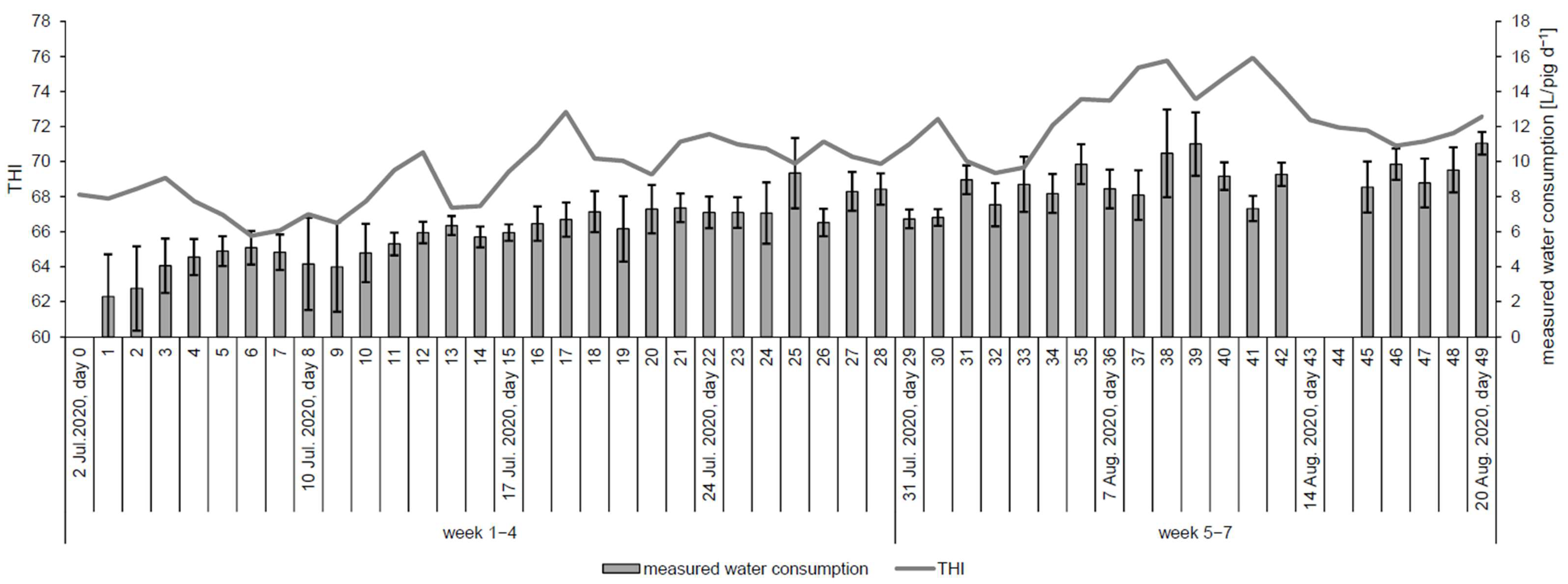
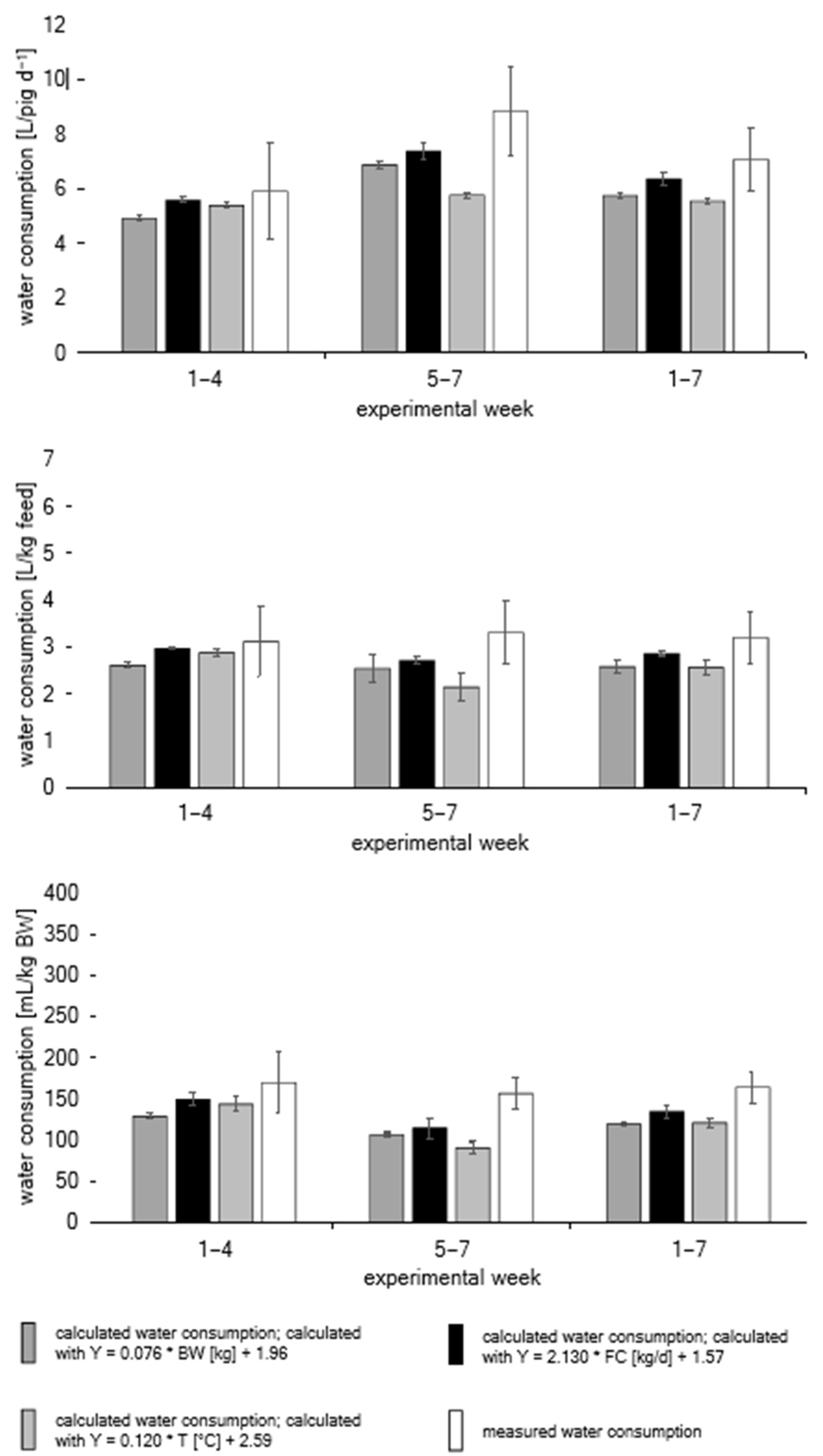
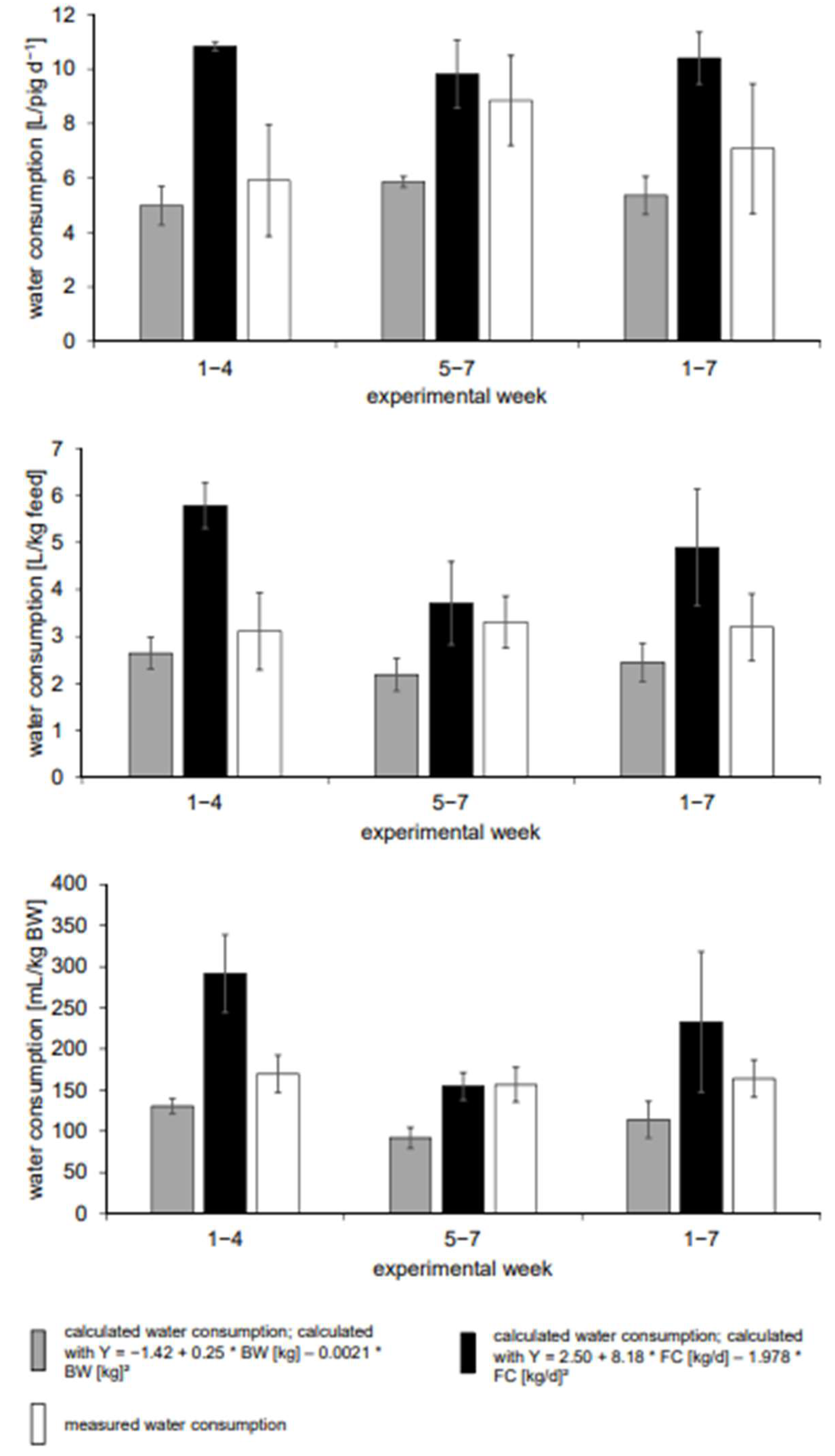
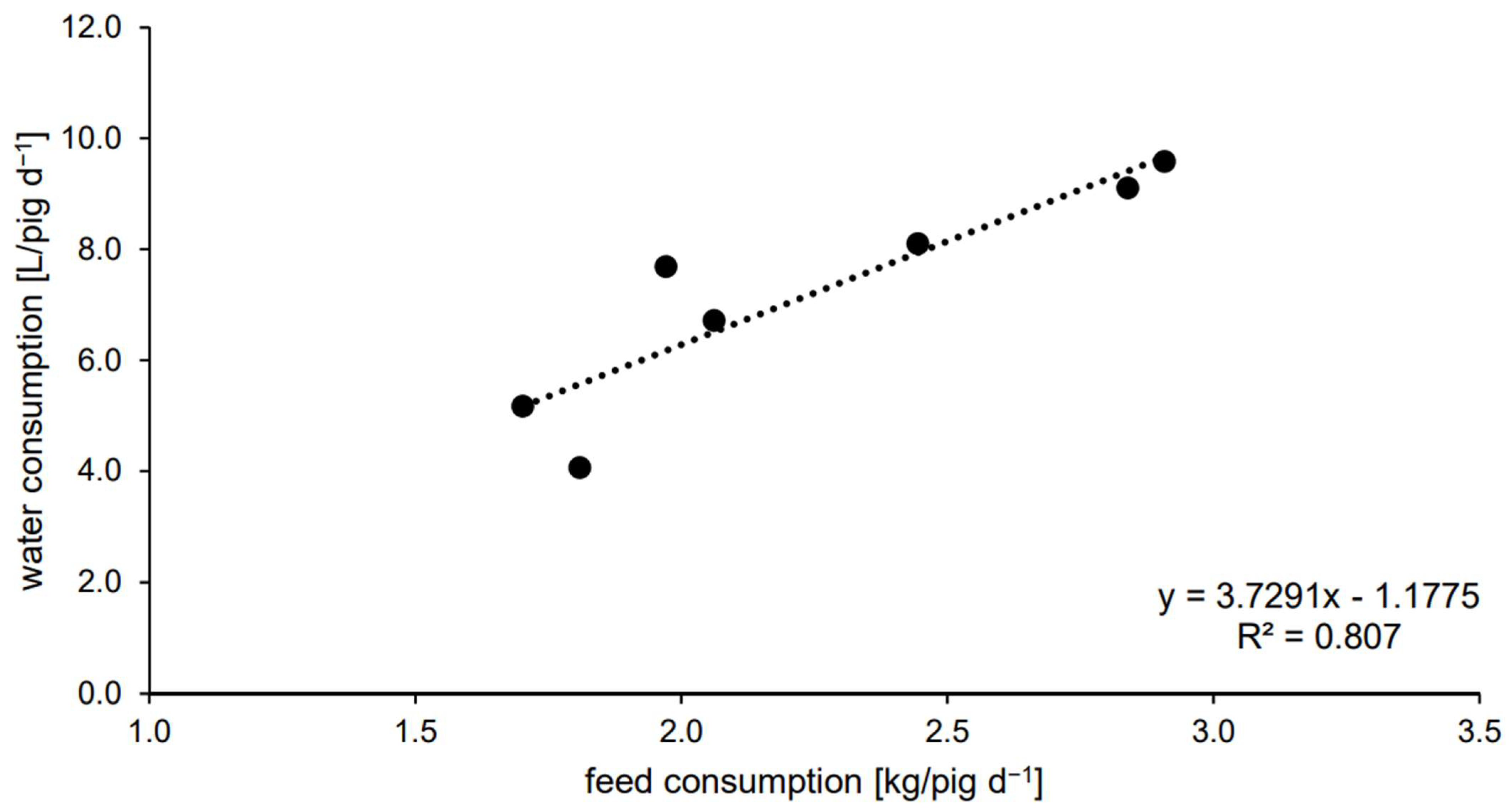
| Parameter | Level | Definition |
|---|---|---|
| tail lesions | 0 | tail without clearly visible bleeding wound, scab or swelling |
| 1 | tail with clearly visible bleeding wound, scab or swelling | |
| ear lesions | 0 | ear without clearly visible bleeding wounds and scabs |
| 1 | clearly visible sores and crusts on the ear (especially occurring at the tip, rim or base of the ear) | |
| skin lesions (except tail and ears) | 0 | <4 line-shaped lesions with ≥5 cm length and no circular lesion with diameter ≥2.5 cm (EUR 2 coin) |
| 1 | ≥4 line-shaped lesions with ≥5 cm length or one flat lesion with a diameter ≥2.5 cm (EUR 2 coin) | |
| manure on the body | 0 | “unsoiled”: <10% of the surface with faecal deposits |
| 1 | “soiled”: ≥10% of the surface with faecal deposits |
| Ingredients [g/kg] | Week 1–4 | Week 5–7 |
| barley | 32.96 | 34.71 |
| wheat | 38.76 | 38.12 |
| soybean meal | 23.79 | 22.69 |
| soya oil | 1.50 | 1.50 |
| premix | 2.99 | 2.98 |
| Nutrient [g/kg dry matter] | Week 1–4 | Week 5–7 |
| dry matter [g/kg] | 901.0 | 894.7 |
| crude protein | 214.3 | 205.3 |
| crude fibre | 42.5 | 39.4 |
| crude fat | 46.0 | 37.6 |
| starch | 452.2 | 464.0 |
| sugar | 39.0 | 38.8 |
| energy [MJ ME/kg] | 13.8 | 13.7 |
| Phase | Week 1–4 | n 1 | Week 5–7 | n 1 | All | n 1 |
|---|---|---|---|---|---|---|
| initial BW [kg] | 24.3 ± 4.3 | 79 | 49.7 ± 6.9 | 79 | 24.3 ± 4.3 | 79 |
| final BW [kg] | 49.7 ± 6.9 | 79 | 72.5 ± 8.8 | 73 | 72.5 ± 8.8 | 73 |
| daily BW gains [g/d] | 906 ± 266 | 316 | 1067 ± 351 | 227 | 973 ± 314 | 543 |
| feed consumption [kg/pig d] | 1.9 ± 0.2 | 16 | 2.8 ± 0.4 | 12 | 2.3 ± 0.5 | 28 |
| feed conversion ratio [kg/kg] | 2.2 ± 0.5 | 16 | 2.7 ± 0.5 | 12 | 2.4 ± 0.5 | 28 |
| water consumption [kg/pig d] | 5.9 ± 2.1 | 112 | 8.8 ± 1.7 | 74 | 7.1 ± 2.4 | 186 |
| Classification THI * | Pen 1 [%] | Pen 2 [%] | Pen 3 [%] | Pen 4 [%] | Mean Pen 1–4 [%] | Central Corridor [%] | Outside [%] |
|---|---|---|---|---|---|---|---|
| n 1 | 71,397 | 71,400 | 71,250 | 71,400 | 4 | 71,400 | 71,400 |
| THI ≤ 74 Normal | 84 | 79 | 88 | 85 | 84 | 93 | 81 |
| THI > 74–≤ 79 Attention | 14 | 17 | 11 | 14 | 14 | 6 | 8 |
| THI > 79–≤ 84 Danger | 2 | 3 | 1 | 1 | 2 | 1 | 5 |
| THI > 84 Emergency | 0 | 0 | 0 | 0 | 0 | 0 | 7 |
| Unit | L/Pig and Day | L/kg Feed | mL/kg BW | ||||||
|---|---|---|---|---|---|---|---|---|---|
| Phase | Week 1–4 | Week 5–7 | All | Week 1–4 | Week 5–7 | All | Week 1–4 | Week 5–7 | All |
| n [values] | 16 | 12 | 28 | 16 | 12 | 28 | 16 | 12 | 28 |
| adjusted p-values | |||||||||
| water consumption | measured | ||||||||
| calculated according to BW 1 | 0.150 | 0.455 | 0.087 | 0.094 | 0.159 | 0.003 | 0.005 | 0.017 | <0.001 |
| calculated according to FC 1 | 1.000 | 1.000 | 1.000 | 1.000 | 1.000 | 1.000 | 1.000 | 0.159 | 0.020 |
| calculated according to T 1 | 1.000 | <0.001 | 0.007 | 1.000 | <0.001 | 0.006 | 0.308 | <0.001 | <0.001 |
| calculated according to BW 2 | 0.464 | <0.001 | 0.005 | 0.242 | <0.001 | <0.001 | 0.009 | <0.001 | <0.001 |
| calculated according to FC 2 | 0.004 | 1.000 | <0.001 | 0.005 | 1.000 | 0.034 | 0.115 | 1.000 | 1.000 |
| Equation | 1 | 2 | 3 | 4 | 5 | 6 |
|---|---|---|---|---|---|---|
| Spearman correlation, n = 89,296 | ||||||
| rs | 0.90 | 0.89 | 0.87 | BW: 0.90 T: 0.87 | BW: 0.90 THI: 0.89 | 0.80 |
| p-value | <0.0001 | <0.0001 | <0.0001 | BW: <0.0001 T: <0.0001 | BW: <0.0001 THI: <0.0001 | <0.0001 |
| Spearman correlation, n = 28 | ||||||
| rs | 0.90 | 0.89 | 0.87 | BW: 0.89 T: 0.87 | BW: 0.89 THI: 0.89 | 0.81 |
| p-value | <0.0001 | <0.0001 | <0.0001 | BW: <0.0001 T: <0.0001 | BW: <0.0001 THI: <0.0001 | <0.0001 |
| Regression analysis, n = 28 | ||||||
| regression model | y = 0.142 * BW [kg] | y = 0.103 * THI | y = 0.295 * T [°C] | y = 0.109 * BW [kg] + 0.072 * T [°C] | y = 0.114 * BW [kg] + 0.021 * THI | y = 3.190 * FC [kg/pig d] |
| f-value (p) | 1209.19 (<0.0001) | 403.36 (<0.0001) | 544.69 (<0.0001) | 670.39 (<0.0001) | 666.31 (<0.0001) | 715.42 (<0.0001) |
| Root Mean Square Error (RMSE) [l/pig d−1] | 1.13 | 1.91 | 1.66 | 1.07 | 1.07 | 1.45 |
| adjusted r-square | 0.98 | 0.93 | 0.95 | 0.98 | 0.98 | 0.96 |
| coefficient variable t-value (p) | 34.77 (< 0.0001) | 20.08 (<0.0001) | 23.34 (<0.0001) | BW: 6.21 (<0.0001) T: 1.96 (0.0605) | BW: 7.70 (<0.0001) THI: 1.92 (0.0663) | 26.75 (<0.0001) |
| Range of application of the new equations: BW: 27.2–75.7 kg/pig; FC: 1.5–3.6 kg/pig d; T: 22.2–28.3 °C; THI: 67.1–75.7 | ||||||
Disclaimer/Publisher’s Note: The statements, opinions and data contained in all publications are solely those of the individual author(s) and contributor(s) and not of MDPI and/or the editor(s). MDPI and/or the editor(s) disclaim responsibility for any injury to people or property resulting from any ideas, methods, instructions or products referred to in the content. |
© 2023 by the authors. Licensee MDPI, Basel, Switzerland. This article is an open access article distributed under the terms and conditions of the Creative Commons Attribution (CC BY) license (https://creativecommons.org/licenses/by/4.0/).
Share and Cite
Schale, P.; Arkenau, E.F.; Schmitt, A.O.; Dänicke, S.; Kluess, J.; Grümpel-Schlüter, A. Estimates of Water Consumption of Growing Pigs under Practical Conditions Based on Climate and Performance Data. Animals 2023, 13, 1547. https://doi.org/10.3390/ani13091547
Schale P, Arkenau EF, Schmitt AO, Dänicke S, Kluess J, Grümpel-Schlüter A. Estimates of Water Consumption of Growing Pigs under Practical Conditions Based on Climate and Performance Data. Animals. 2023; 13(9):1547. https://doi.org/10.3390/ani13091547
Chicago/Turabian StyleSchale, Patrick, Engel F. Arkenau, Armin O. Schmitt, Sven Dänicke, Jeannette Kluess, and Angelika Grümpel-Schlüter. 2023. "Estimates of Water Consumption of Growing Pigs under Practical Conditions Based on Climate and Performance Data" Animals 13, no. 9: 1547. https://doi.org/10.3390/ani13091547
APA StyleSchale, P., Arkenau, E. F., Schmitt, A. O., Dänicke, S., Kluess, J., & Grümpel-Schlüter, A. (2023). Estimates of Water Consumption of Growing Pigs under Practical Conditions Based on Climate and Performance Data. Animals, 13(9), 1547. https://doi.org/10.3390/ani13091547







